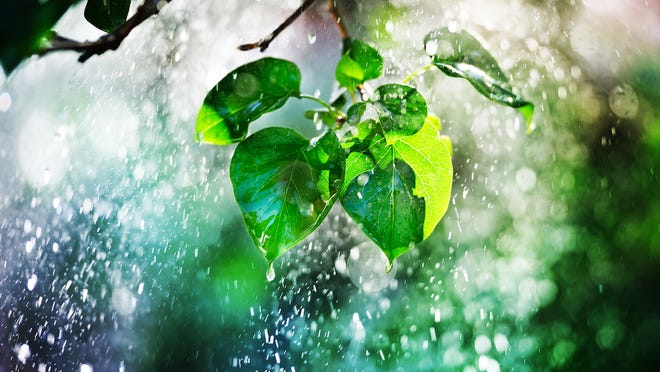Gardening: Let the rainy season begin!

Wow! Flooding rains of June. Let the rainy season begin! We needed the water to replenish our aquifers after our dry season, but our plants would prefer it not come all at once.
A lot of roots don’t like to sit in water. Heavy rains can saturate the soil and accumulate in areas causing plants to “stand” in water for days. Adding soil and root stimulant amendments like mycorrhizal fungi, beneficial bacteria and rooting hormones can help these plants recover. Normally when you think of fungi and bacteria the thoughts are not good. However, all can be powerhouses for healthy root development.
More:Gardening: Selecting, trimming trees for hurricane season
Roots absorb, and feed needed minerals and water to the plant from the soil. Roots can also store food and can even reproduce new plants vegetatively. They are a very important part of the plant. The roots are the part of the plant that grow down and branch to form a root system to anchor the plant in the soil as well as feeding it.
Water and nutrient uptake are accomplished by tiny, thin-walled root hairs that line the main root. Root hairs are extensions of individual root cells which penetrate the soil to absorb water and minerals. Root hair loss through transplanting or rot from too much moisture can stress the plant, stop it from growing and possibly cause death. When root loss or damage happens, a plant will try to produce new roots to achieve the previous size and balance the root system with the above ground growth.

Mycorrhizal fungi can be a big help in recovery by inhabiting the fine roots of plants. These fungi feed from the sugars in the plants and in return grow mycelia. These are fungi fingers which act as feeding tubes and extend the root surface allowing for better absorption of water and nutrients. Like roots on steroids. This in turn increases the plants tolerance to stresses from poor soil conditions like salt build up after a hurricane, drought or rot from heavy rains.
For water saturated soil after flooding rains, certain bacteria can help reduce pathogens which cause root diseases and improve root growth. Torn and damaged root systems will be more susceptible to disease.
More:Gardening: Add some perennials in with your summer annuals
There are many products on the market containing these beneficial ingredients. Look for mycorrhizal and beneficial bacteria on the label. These products produce a more robust root system to absorb and use nutrients and water more efficiently. After hurricanes or wind storms work the soil and amendments into the uprooted or water soaked area. Wash these in by poking the hose into the soil around the roots to fill in any air pockets and to wash the beneficial amendments and soil into the damaged roots where they can go to work healing a weary root system. Farmers are adding it to fertilizer to increase crop production and health.
It is best to avoid fertilizing during times when heavy rains are expected. The nutrients flush right through our sandy soil, or even worse, run off when applied before heavy rains and become a direct cause of pollution in the Gulf of Mexico. However, stressed plants will need these nutrients to recover. And therefore, I am not in favor of the summer blackout periods some communities impose on fertilizing. The summer months are when the plants grow most vigorously and need and use the nutrients in the soil for this growth. If the nutrients in the soil are all lost with early heavy rains the plants have nothing to work with by late July or August and their health and vigor can suffer.
Root damage does not appear overnight. It takes time for damaged roots to develop disease and die. Plants may begin to decline and die months or even years after a flood, hurricane or other stressor has passed. If there is no reason that you can see for the decline of your plant, it may be latent root damage from sitting in a flooded area for two or three days or the seemingly minor uprooting from a passing storm. Try some fungus and bacteria. You might save these plants and watch them flourish again in your landscapes. That is if they still have some fertilizer left from the spring fertilization to make it to October because they will also need food. Remember that the healthy roots of all plants and grass are the best filters for the Earth of all pollutants. We should give them everything they need when they need it.
More:Gardening: The fertilizer deadline nears
Eileen and Peter Ward have owned a landscape and lawn maintenance company for 35 years. Eileen can be reached at Gswdmarco@comcast.net or 239-394-1413.